英语时态结构、时间状语与频度副词
英语常用时态

Shall/Will+主语+动词原形
Shall we go to Beijing next week?Will she go to Beijing next week?
特殊疑问句
疑问代词/疑问副词+shall/will+主语+动词原形
When shall we go to Beijing?When will she go to Beijing?
4. 表示客观真理或永恒的状态。如:The sun rises in the east. The sun sets in the west. 太阳从东边升起,从西边落下。 5. 现阶段的状态。常跟时间副词now连用。如:He lives with his grandfather now. 他现在跟奶奶住一起。6. 习惯性的爱好或行为。如:I like dancing while she likes singing. 我喜欢跳舞,而她喜欢唱歌。7. 表示已经计划、安排好了或时间表上所安排,并且一定要做的事情。用于这种句型的动词主要是瞬间动词:come, go, leave, arrive, begin, start, stop, close, open等。如:Are you on duty next weekend? 下周末你上班吗?
一般将来时用法
1. 一般将来时:表示某一时刻的动作或状态,或将来某一段时间内经常发生的动作或状态。2. 常与表示将来的时间状语连用。如tomorrow, next week, next year, in the future等。3. 由助动词shall(第一人称), will(第二、三人称)+动词原形构成。或用主语+be动词+going to+动词原形4. 在口语中,will常缩略为’ll,will not常缩略为won’t.5. 在表示带有意愿色彩的将来时,常用助动词will. 如:I will tell you all about it.6. 在疑问句中,主语为第一人称(I 和 we)时,常用助动词shall. 如:When shall we have the party?7. 在书面语中,主语为第一人称(I 和 we)时,也常用助动词shall。如:I shall write you a letter next week. 但在口语中,所有助动词都用will,尤其是在美国。8. be going to + 动词原形也可以表示将要发生的动作或安排、或打算、计划、决定要做的事。如:The Smiths are going to see a Peking opera this evening.They are going to play volleyball next week. I’m going to be twenty next Tuesday. Where are you going to work?
(完整)初中英语6大时态
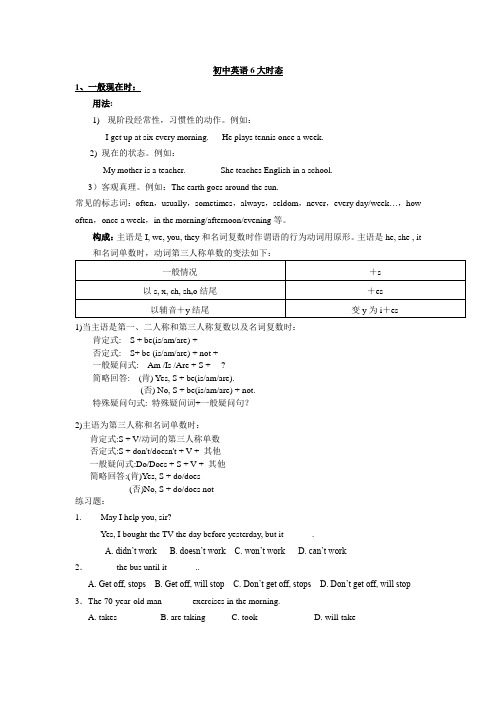
初中英语6大时态1、一般现在时:用法:1)现阶段经常性,习惯性的动作。
例如:I get up at six every morning. He plays tennis once a week.2) 现在的状态。
例如:My mother is a teacher. She teaches English in a school.3)客观真理。
例如:The earth goes around the sun.常见的标志词:often,usually,sometimes,always,seldom,never,every day/week…,how often,once a week,in the morning/afternoon/evening等。
构成:主语是I, we, you, they和名词复数时作谓语的行为动词用原形。
主语是he, she , it1)当主语是第一、二人称和第三人称复数以及名词复数时:肯定式: S + be(is/am/are) + ···否定式: S+ be (is/am/are) + not + ···一般疑问式: Am /Is /Are + S + ···?简略回答: (肯) Yes, S + be(is/am/are).(否) No, S + be(is/am/are) + not.特殊疑问句式: 特殊疑问词+一般疑问句?2)主语为第三人称和名词单数时:肯定式:S + V/动词的第三人称单数否定式:S + don't/doesn't + V + 其他一般疑问式:Do/Does + S + V + 其他简略回答:(肯)Yes, S + do/does(否)No, S + do/does not练习题:1.--- May I help you, sir?--- Yes, I bought the TV the day before yesterday, but it ______.A. didn’t workB. doesn’t workC. won’t workD. can’t work2.______ the bus until it ______..A. Get off, stopsB. Get off, will stopC. Don’t get off, stopsD. Don’t get off, will stop 3.The 70-year-old man ______ exercises in the morning.A. takesB. are takingC. tookD. will take用法:1).将要发生的动作。
英语时态结构时间状语与频度副词
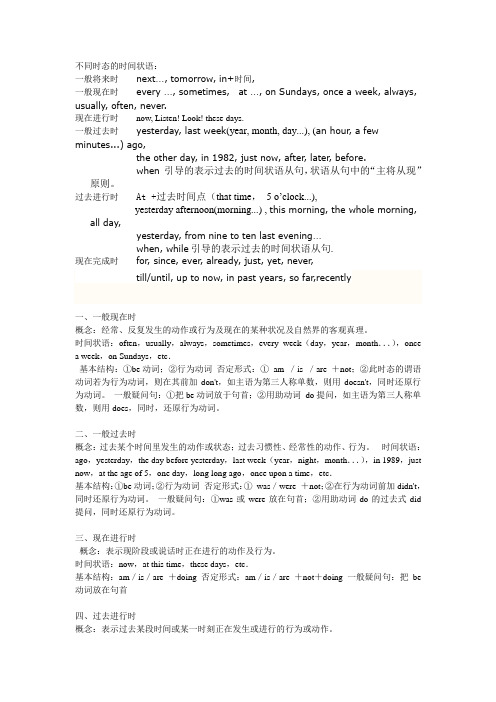
不同时态的时间状语:一般将来时next…, tomorrow, in+时间,一般现在时every …, sometimes,at …, on Sundays, once a week, always, usually, often, never.现在进行时now, Listen! Look! these days.一般过去时yesterday, last week(year, month, day...), (an hour, a few minutes...) ago,the other day, in 1982, just now, after, later, before.when 引导的表示过去的时间状语从句,状语从句中的“主将从现”原则。
过去进行时At +过去时间点(that time, 5 o’clock...),yesterday afternoon(morning...) , this morning, the whole morning, all day,yesterday, from nine to ten last evening…when, while引导的表示过去的时间状语从句.现在完成时for, since, ever, already, just, yet, never,till/until, up to now, in past years, so far,recently一、一般现在时概念:经常、反复发生的动作或行为及现在的某种状况及自然界的客观真理。
时间状语:often,usually,always,sometimes,every week(day,year,month...),once a week,on Sundays,etc.基本结构:①be动词;②行为动词否定形式:①am /is /are +not;②此时态的谓语动词若为行为动词,则在其前加don't,如主语为第三人称单数,则用doesn't,同时还原行为动词。
频度副词及时间表达法

频度副词含义:表示次数,频率的副词称为频度副词。
比如像usually,sometimes,always,often.位置:(1)在be动词之后,eg:she is sometimes very busy.他有时很忙。
(2)在第一个助动词或情态动词之后,eg:I will never forget the first time I met you.我永远不会忘记我们的第一次见面。
(3)在实意动词之前。
We often go there.我们经常去那儿。
(4)sometimes可放在句首、句中或句末,often放在句中或句末。
Eg:sometimes she watches TV.他有时看电视。
She watches TV often.用法:often,always,usually,等常和一般现在时连用,表示经常或反复发生的动作.Eg:it often rains here.·对频度副词的提问用how often.Eg;I sometimes write to my brother。
有时候,我写信给我的弟弟。
How often do you write to your brother?你多久给你弟弟写一次信?辨析:sometimes,some times,sometime,some timeSometimes,频度副词,意为“有时”Some times名词短语,意为“好多次,"“几倍'sometime副词意为过去或将来的某个时候Some time名词短语意为“一段时间"Eg:I sometimes play games with her。
我有时和他玩游戏。
I have read the book some times.这本书我已经读了这本书好几遍了。
Come to see us sometime.找个时间来看我们。
I will stay here for some time。
八种常见时态的结构 搭配连词及用法

过去 将来时
would+V-原
1.用于宾从中,主从句时态
一致
2.委婉语气中
现在 进行时
1.now 2.at the is/am/are+V-ing moment 3.look!
listen!be quiet!
1.进行时态表将来 2.与always连用,带感情色 彩 3.be getting+公式,变 得更……
过去 had+V-ed(过分 1.by短语
完成时 )
2.before,when+句子
过去 进行时
was/were+V-ing
1.过去某一刻 2.when,while 3.at that moment
现在 have/has+V-ed( 完成时 过分)
1.just 2.already,yet 3.since,for 4.never,ever 5.up to now,sofar
1.①.have been to去过 ②.have gone to去了 2.句型:It's+段时间+ since+句子 3.现完中,短 暂性动词不与段时间连用
1.客观真理和事实 2.感情感官动词 3.if条件状 从,主将从现 4.here, there开头用一般现在时
1.说话时动作已发生 2.谈论已死的人的事,用一 般过去时
1.①be going to+V-原a.安 排计划的动作b.预测(天 气)②will/shall+V原表纯 粹的将来b.表个人意愿 2.There be:①there will be②there is going to be
八种常见时态
时态
结构
连用词
英语8大时态结构

英语8大时态结构1. Simple Present Tense(1)表示经常性的或习惯性的动作,常和表示频度的副词(sometimes,usually,always 等)连用,常用第三人称单数。
例如:My father often tells me stories.(2)表示一般真理、客观事实或格言。
例如:The sun rises in the east.2. Present Continuous Tense(1)表示现阶段正在进行的动作或存在的状态,可以用来表示暂时的动作或状态。
例如:She is reading a book.(2)表示临时的、突发的动作或存在的状态。
例如:I'm waiting for the bus.3. Simple Past Tense(1)表示过去发生的动作或存在的状态,一般没有时间的限制。
例如:I went to my friend's home yesterday.(2)表示过去经常、习惯性的动作。
例如:I used to play football.4. Past Continuous Tense(1)表示过去持续性的动作或存在的状态。
例如:I was having dinner when you called me last night.(2)表示过去和现在的对比。
例如:She was listening to music while I was doing my homework.5. Present Perfect Tense(1)表示过去发生的动作对现在产生的影响,体现在现在的结果。
例如:She has finished her homework.(2)表示从过去某一时刻开始到现在为止发生的动作。
例如:He has lived in this city for two years.6. Present Perfect Continuous Tense(1)表示从过去开始一直持续到现在的动作或存在的状态。
高中英语十六种时态

添加标题
定义:一般现在时表示习惯或 常规,通常用于描述经常发生 的动作或状态。
添加标题
用法:一般现在时通常与频度 副词如“always”、 “often”、“sometimes” 等连用,表示某个动作或状态 发生的频率。
添加标题
形式:一般现在时的形式是动 词原形,第三人称单数时在动 词后加“-s”或“-es”。
注意事项:在使 用一般现在时描 述客观事实或普 遍真理时,要注 意避免使用主观 性的词汇或语气, 保持客观和中立 的态度。
定义:表示正在进行的动作或存在的状态
构成:be动词+动词ing
用法:可以表示现在正在进行的动作或存在的状态,也可以表示将来要发生的动作或存在 的状态
示例:I am studying English right now.(我现在正在学习英语。)
,
01 一 般 现 在 时 02 现 在 进 行 时 03 现 在 完 成 时 04 现 在 完 成 进 行 时
定义:一般现在时表示现在发生的动作或状态,常与一般现在时的基本用法相联系 构成:动词原形或第三人称单数形式 时间状语:always,usually,often,sometimes,every day等 基本用法:表示习惯性、经常性、普遍性的动作或状态
构成:have/has+过去分词 用法:动作或状态从过去开始,持续到现在或将来 时间状语:already, yet, just, before, since等 语境:常与现在完成时连用,表示过去的动作对现在造成的影响或结果
定义:现在完成时表示过去发生 的动作或状态对现在造成的影响 或结果。
用法:常与already, yet, just, ever, never等副词连用。
16种英语时态(经典收藏版)-太全了!
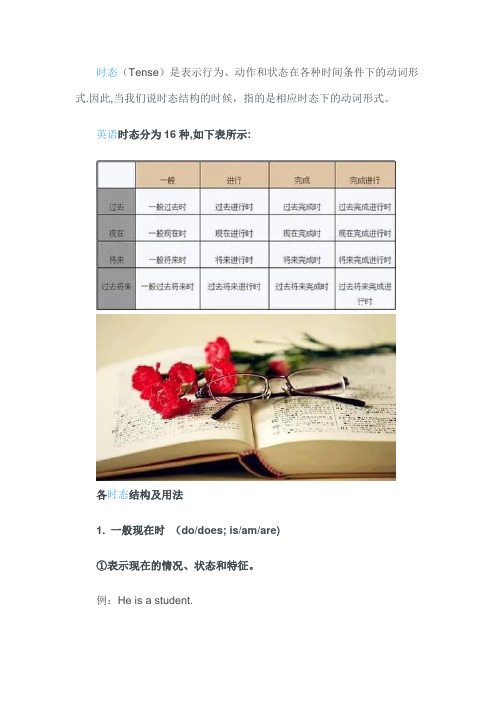
时态(Tense)是表示行为、动作和状态在各种时间条件下的动词形式.因此,当我们说时态结构的时候,指的是相应时态下的动词形式。
英语时态分为16种,如下表所示:各时态结构及用法1. 一般现在时(do/does; is/am/are)①表示现在的情况、状态和特征。
例:He is a student.他是一个学生.②表示经常性、习惯性动作。
例:He always helps others.他总是帮助别人.③客观事实和普遍真理。
例:The earth moves the sun.地球绕着太阳转.④表示一个按规定、计划或安排要发生的动作.(常用于列车、客车、飞机或轮船时刻表)例:The next train leaves at 3 o’clock this afternoon。
下一趟火车今天下午3点开车。
⑤主将从现:在时间、条件和让步状语从句中经常用一般现在表示将的来事情。
例:If it rains tomorrow, we will stay at home.如果明天下雨,我们会待在家里。
2。
现在进行时(am/is/are doing)①表示此时此刻正在发生的事情。
例:He is listning to the music now。
他现在正在听音乐。
②表示目前一段时间内一直在做的事情,但不一定此时此刻正在做。
例:I am studying by using Qisu English APP this term.这个学期我一直在使用奇速英语APP学习。
③现在进行时可以表示将来的含义。
瞬时动词的进行一定表将来。
例:I am leaving。
我要离开了。
持续动词的进行只有有将来的时间状语或有将来语境中才表将来。
例: I am travelling next month。
下个月我要去旅行。
④现在进行时与频度副词连用,表示说话者或褒义或贬义的感情色彩。
例: He is always helping others.他总是帮助别人。
英语16种时态表格总结

英语16种时态表格总结各时态结构及具体用法:1.一般现在时(do/does; is/am/are)①表示现在的情况、状态和特征。
例:He is a student.他是一个学生。
②表示经常性、习惯性动作。
例:He always helps others.他总是帮助别人。
③客观事实和普遍真理。
例:The earth moves the sun.地球绕着太阳转。
④表示一个按规定、计划或安排要发生的动作。
(常用于列车、客车、飞机或轮船时刻表)例:The next train leaves at 3 o'clock this afternoon.下一趟火车今天下午3点开车。
⑤主将从现:在时间、条件和让步状语从句中经常用一般现在表示将的来事情。
例:If it rains tomorrow, we will stay at home.如果明天下雨,我们会待在家里。
2.现在进行时(am/is/are doing)①表示此时此刻正在发生的事情。
例:He is listning to the music now.他现在正在听音乐。
②表示目前一段时间内一直在做的事情,但不一定此时此刻正在做。
例:I am studying computer this term.这个学期我一直在学习计算机。
③现在进行时可以表示将来的含义。
瞬时动词的进行一定表将来。
例:I am leaving.我要离开了。
持续动词的进行只有有将来的时间状语或有将来语境中才表将来。
例:I am travelling next month.下个月我要去旅行。
④现在进行时与频度副词连用,表示说话者或褒义或贬义的感情色彩。
例:He is always helping others.他总是帮助别人。
(褒义)3.过去进行时(was/ were doing)①表示在过去一个具体的时间正在发生的动作。
例:Mary was listening to light music 10 minutes ago.10分钟前,玛丽正在听轻音乐。
英语语法时态总结

英语语法时态1.结构肯定句式: 主语+动词原形/动词的第三人称单数+其他否定句式: 1. 主语+be+not +其他 2.主语+don't/doesn't +动词原形+其他一般疑问句式:--Be+主语+其他? -Yes,主语+be. -No,主语+be+not.--Do/Does+主语+动词原形+其他? -Yes,主语+do/does -No,主语+do/does not(don't = do not doesn't = does not)例句:I like apples.Do you like apples?He often goes swimming in summer.She usually leaves home for school at 7 every morning.常用的频度副词有:always、often、usually、seldom、never、sometimes, every week (day, year, month…), once a week, on Sundays.频度副词在句中通常放在行为动词之前,系动词、助动词之后。
1.结构肯定句式: 主语+动词过去式+其他否定句式: 主语+didn’t +动词原形+其他+did not.2.用法表示过去某一时刻或某一段时间里所发生的动作或情况。
时间状语yesterday, just now, the other day, in 1982, ago, an hour ago, long long ago, the day before yesterday, last week(year, night, month…), at the age of 5, one day, once upon a time等连用例如:Where did you go just now?After a few years, she started to play the piano.I played soccer yesterday.Did you see him just now?1:肯定句式:主语+助动词will+动词原形+其他否定句式:主语+助动词will+动词原形+not+其他一般疑问句式:助动词Will+主语+动词原形+其他简单回答:在口语中,will在名词或代词后常缩为’ll,wii not常简缩为won’t。
初中英语八大时态结构及用法

初中英语八大时态结构及用法时态无疑是初中英语最重要的语法内容,学好时态基本就拿下了语法的半壁江山。
英语八大时态:一、一般现在时标志:动词原形1. 表示经常性或习惯性动作,常与表频度的时间状语连用:She often speaks English.I leave home for school at 7 every morning.2. 表示现在的状态、特征、职业、能力、感觉等:He seems to feel a bit down today.He works as a driver.3. 表示真理、客观存在、科学事实或用于格言警句中:Shanghai lies in the east of China.Columbus proved that the earth is round.Where there is a will, there is a way.4. 表示现在瞬间的动作:Here comes the bus!5. 表示将来:1)表按规定、计划、安排将要发生的动作(仅限于某些表示“来、去、动、停、开始、结束、继续”等的趋向动词),可以与表示未来的时间状语搭配使用。
常见的用法是:飞机、火车、轮船、汽车等定期定点运行的交通状况。
如:The next train leaves at 3 o’clock this afternoon.How often does the shuttle bus run?2)在时间和条件状语从句中常使用一般现在时表示将来发生的事情:When Bill comes(不用will come)ask him to wait for me.I shall go there tomorrow unless I’m too busy.二、一般过去时标志:动词过去式闭音节:元音字母a, e, i, o, u如果发字母本来的音则称为开音节,否则称为闭音节。
1. 表示过去某时所发生的动作或存在的状态,常与表示过去的时间状语连用(e.g. yesterday, this morning, just now, a moment ago, in May, last night / year / week, once upon a time, the other day, before …, when …, in the past等)。
英语必考八大时态结构及用法详解

英语必考八大时态结构及用法详解一、一般现在时1. 概念:经常、反复发生的动作或行为及现在的某种状况.2. 基本结构:①is/am/are;②do/does否定形式:①am/is/are+not;②此时态的谓语动词若为行为动词,则在其前加don't,如主语为第三人称单数,则用doesn't,同时还原行为动词.3。
一般疑问句:①把is/am/are动词放于句首;②用助动词do提问,如主语为第三人称单数,则用does,同时,还原行为动词.4。
用法1) 经常性或习惯性的动作,常与表示频度的时间状语连用.例如:I leave home for school at 7 every morning。
每天早上我七点离开家.2) 客观真理,客观存在,科学事实。
例如:The earth moves around the sun。
地球绕太阳转动.Shanghai lies in the east ofChina. 上海位于中国东部.3) 表示格言或警句。
例如:Pride goes before a fall. 骄者必败。
注意:此用法如果出现在宾语从句中,即使主句是过去时,从句谓语也要用一般现在时。
例如:Columbus proved that the earth is round. 哥伦布证实了地球是圆的.4) 现在时刻的状态、能力、性格、个性.例如:I don’t want so much。
我不要那么多.Ann writes good English but does not speak well.安英语写得不错,讲的可不行.5) 一般现在时表示将来含义a。
下列动词come,go, arrive, leave, start,begin, return的一般现在时可以表示将来,主要用来表示在时间上已确定或安排好的事情。
例如:The train leaves at six tomorrow morning。
英语六大时态归纳与练习(含答案)
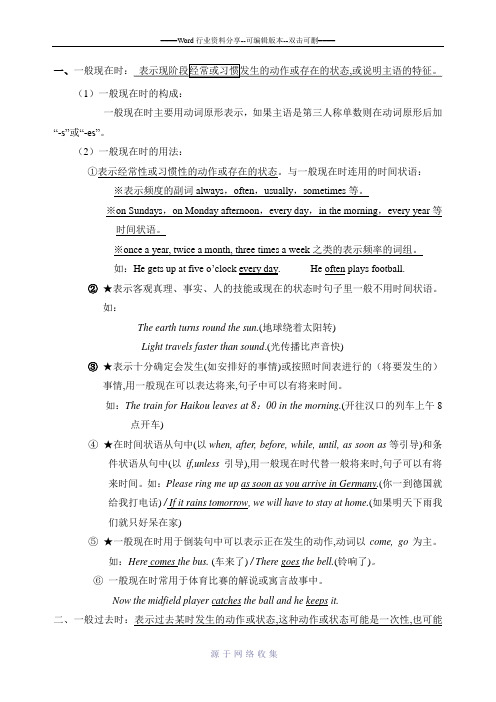
一、(1)一般现在时的构成:一般现在时主要用动词原形表示,如果主语是第三人称单数则在动词原形后加“-s”或“-es”。
(2)一般现在时的用法:①表示经常性或习惯性的动作或存在的状态。
与一般现在时连用的时间状语:※表示频度的副词always,often,usually,sometimes等。
※on Sundays,on Monday afternoon,every day,in the morning,every year等时间状语。
※once a year, twice a month, three times a week之类的表示频率的词组。
如:He gets up at five o’clock every day. He often plays football.②★表示客观真理、事实、人的技能或现在的状态时句子里一般不用时间状语。
如:The earth turns round the sun.(地球绕着太阳转)Light travels faster than sound.(光传播比声音快)③★表示十分确定会发生(如安排好的事情)或按照时间表进行的(将要发生的)事情,用一般现在可以表达将来,句子中可以有将来时间。
如:The train for Haikou leaves at 8:00 in the morning.(开往汉口的列车上午8点开车)④★在时间状语从句中(以when, after, before, while, until, as soon as等引导)和条件状语从句中(以if,unless引导),用一般现在时代替一般将来时,句子可以有将来时间。
如:Please ring me up as soon as you arrive in Germany.(你一到德国就给我打电话) / If it rains tomorrow, we will have to stay at home.(如果明天下雨我们就只好呆在家)⑤★一般现在时用于倒装句中可以表示正在发生的动作,动词以come, go为主。
英语16种时态结构及例句

1. 一般现在时(do/does; is/am/are)①现在的动作、情况、状态和特征。
例:She is a teacher.她是一位老师②经常性、习惯性动作。
例:He always helps others.他总是帮助别人。
③客观事实和普遍真理。
如果前后文不是一般现在时,则无法保持主句、从句时态一致。
例:The earth moves round the sun.地球绕着太阳转。
④表示一个按规定、计划或安排要发生的动作。
例:The next train leaves at 3 o'clock this afternoon.下一趟火车今天下午3点开车。
⑤在时间和条件状语从句里经常用一般现在(有时也用现在完成时)表示将来事情。
例:When you have finished the report, I will have waited for about 3 hours.等你完成这份报告的时候,我就已经等了将近3个小时了。
2. 现在进行时(am/is/are doing)①表示此时此刻正在发生的事情。
例:He is listning to the music now.他现在正在听音乐。
②表示目前一段时间内一直在做的事情,但不一定此时此刻正在做。
例:I am studying computer this term.这个学期我一直在学习计算机。
③现在进行时可以表示将来的含义。
瞬时动词的进行一定表将来。
例:I am leaving.我要离开了。
持续动词的进行只有有将来的时间状语或有将来语境中才表将来。
例:I am travelling next month.下个月我要去旅行。
④现在进行时与频度副词连用,表示说话者或褒义或贬义的感情色彩。
例:He is always helping others.他总是帮助别人。
(褒义)3. 现在完成时(have/has done)①表示动作到现在为止已经完成或刚刚完成,强调对现在产生的影响。
初中英语语法八大时态总结(完整版)
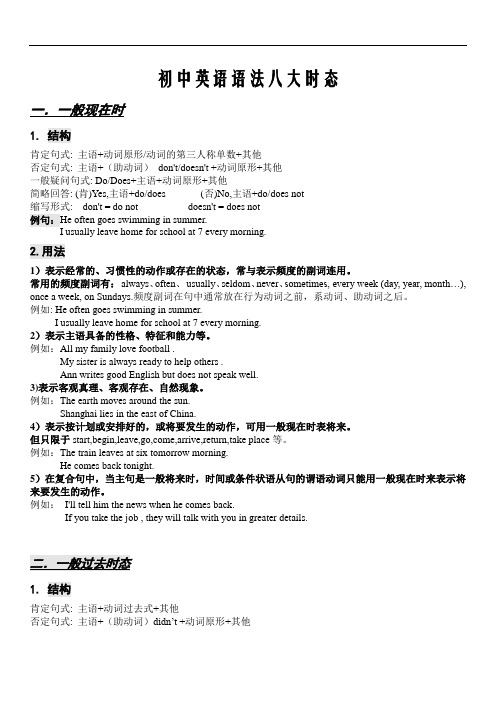
初中英语语法八大时态一.一般现在时1.结构肯定句式: 主语+动词原形/动词的第三人称单数+其他否定句式: 主语+(助动词)don't/doesn't +动词原形+其他一般疑问句式: Do/Does+主语+动词原形+其他简略回答: (肯)Yes,主语+do/does (否)No,主语+do/does not缩写形式: don't = do not doesn't = does not例句:He often goes swimming in summer.I usually leave home for school at 7 every morning.2.用法1)表示经常的、习惯性的动作或存在的状态,常与表示频度的副词连用。
常用的频度副词有:always、often、usually、seldom、never、sometimes, every week (day, year, month…), once a week, on Sundays.频度副词在句中通常放在行为动词之前,系动词、助动词之后。
例如: He often goes swimming in summer.I usually leave home for school at 7 every morning.2)表示主语具备的性格、特征和能力等。
例如:All my family love football .My sister is always ready to help others .Ann writes good English but does not speak well.3)表示客观真理、客观存在、自然现象。
例如:The earth moves around the sun.Shanghai lies in the east of China.4)表示按计划或安排好的,或将要发生的动作,可用一般现在时表将来。
英语语法八大时态总结建议收藏

英语语法八大时态总结,建议收藏!英语8大时态总结英语语法一直都是英语学习的一项重点和难点,而在这其中时态无疑是英语学习最重要的语法内容,学好时态基本就拿下了语法的半壁江山。
今天,帮大家总结的八种时态是大家在英语学习中必学必考的,复习时一定要加倍重视哦!一般现在时1.概念:经常、反复发生的动作或行为及现在的某种状况。
2.基本结构:①is/am/are;②do/does.否定形式:①am/is/are+not;②此时态的谓语动词若为行为动词,则在其前加don t,如主语为第三人称单数,则用doesn t,同时还原行为动词。
3.一般疑问句:①把is/am/are动词放于句首;②用助动词do提问,如主语为第三人称单数,则用does,同时,还原行为动词。
4.用法(1)经常性或习惯性的动作,常与表示频度的时间状语连用。
例如:I leave home for school at7every morning.每天早上我七点离开家。
(2)客观真理,客观存在,科学事实。
例如:The earth moves around the sun.地球绕太阳转动。
Shanghai lies in the east of China.上海位于中国东部。
(3)表示格言或警句。
例如:Pride goes before a fall.骄者必败。
注意:此用法如果出现在宾语从句中,即使主句是过去时,从句谓语也要用一般现在时。
例如:Columbus proved that the earth is round.哥伦布证实了地球是圆的。
(4)现在时刻的状态、能力、性格、个性。
例如:I don t want so much.我不要那么多。
Ann writes good English but does not speak well.安英语写得不错,讲的可不行。
(5)一般现在时表示将来含义a.下列动词come,go,arrive,leave,start,begin,return的一般现在时可以表示将来,主要用来表示在时间上已确定或安排好的事情。
初中英语时态用法详解
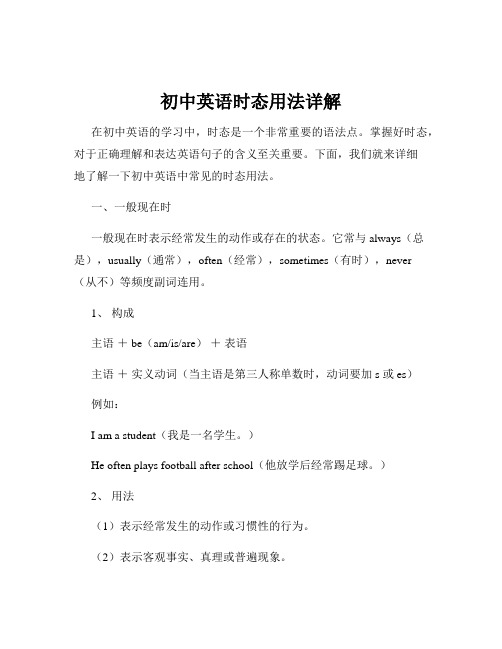
初中英语时态用法详解在初中英语的学习中,时态是一个非常重要的语法点。
掌握好时态,对于正确理解和表达英语句子的含义至关重要。
下面,我们就来详细地了解一下初中英语中常见的时态用法。
一、一般现在时一般现在时表示经常发生的动作或存在的状态。
它常与 always(总是),usually(通常),often(经常),sometimes(有时),never(从不)等频度副词连用。
1、构成主语+ be(am/is/are)+表语主语+实义动词(当主语是第三人称单数时,动词要加 s 或 es)例如:I am a student(我是一名学生。
)He often plays football after school(他放学后经常踢足球。
)2、用法(1)表示经常发生的动作或习惯性的行为。
(2)表示客观事实、真理或普遍现象。
(3)在时间、条件状语从句中,用一般现在时表示将来。
二、一般过去时一般过去时表示过去某个时间发生的动作或存在的状态。
1、构成主语+ be(was/were)+表语主语+实义动词的过去式例如:I was at home yesterday(昨天我在家。
)She went to Beijing last year(她去年去了北京。
)2、用法(1)表示过去发生的动作或存在的状态。
(2)表示过去经常或反复发生的动作。
三、一般将来时一般将来时表示将来要发生的动作或存在的状态。
1、构成(1)will +动词原形(2)be going to +动词原形I will go to the zoo tomorrow(明天我将去动物园。
)They are going to have a party next week(他们下周将举行一个聚会。
)2、用法(1)表示将来要发生的动作或存在的状态。
(2)表示计划、打算做某事。
四、现在进行时现在进行时表示现在正在进行的动作。
1、构成主语+ be(am/is/are)+现在分词例如:They are playing basketball now(他们现在正在打篮球。
- 1、下载文档前请自行甄别文档内容的完整性,平台不提供额外的编辑、内容补充、找答案等附加服务。
- 2、"仅部分预览"的文档,不可在线预览部分如存在完整性等问题,可反馈申请退款(可完整预览的文档不适用该条件!)。
- 3、如文档侵犯您的权益,请联系客服反馈,我们会尽快为您处理(人工客服工作时间:9:00-18:30)。
不同时态的时间状语:(对应之前表格中的基本形式)(一)一般将来时next…, tomorrow, in+时间,1.I will /shall go to school next week/in amouth/tomorrow.译:我下周/一个月/明天要去学校。
2.I am going to wash the clothes next week/in amouth/tomorrow.译:我下周/一个月/明天要洗衣服(二)一般现在时every …, sometimes,at …, onSundays, once a week, always, usually, often, never.1表示平时习惯性,常常做的动作;例:I get up early every day.(我每天早早起床)——每天习惯做的事情2.述不可改变的真理,如地球绕着太阳转。
例:The earth goes round the sun.(地球绕着太阳转)——可以看做地球习惯性的常做的动作(三)现在进行时now, Listen! Look! these days.1.is cleaning the windows now他正在擦玻璃现在,调整语序为:他现在正在擦玻璃。
2.Listen!Mr Smith is singing in the classroom.听,史密斯先生正在教室唱歌。
3.My mother is learning English these days.我的妈妈这几天在学英语。
(几天一直在持续进行的动作。
)(四)一般过去时yesterday, last week(year, month,day...), (an hour, a few minutes...) ago,the other day, in 1982, just now, after, later, before.when 引导的表示过去的时间状语从句,状语从句中的“主将从现”原则(即主句将来时,从句一般现在时)。
1.I visited the old man alone yesterday.昨天我独自去看望了那位老大爷。
2.We had a final exam last week.我们上周举行了期末考试。
3.He waved his hand a few minutes ago.几分钟前,他挥了下他的手。
4.(travel on business/be on a business trip——出差)5.(四)过去进行时(was/were doing something)At +过去时间点(that time,5 o’clock...),yesterday, from nine to ten last evening(昨天晚上九到十点)…when, while引导的表示过去的时间状语从句.1.I was watching TV at 5 o’clock.(5点的时候,我正在看电视)2.She was playing the piano the whole morning/all day.她整个上午/一整天都在弹钢琴。
4.when后通常用表示暂短性动词,while后通常用表示持续性动词,而while所引导的状语从句中,谓语动词常用进行时态,如:When the car exploded I was walking past it.指在走过这辆车的持续性过程中,发生了一个瞬间的短暂性的动作,即汽车爆炸。
When 后面从句谓语动词用exploded= While I was walking past ,the car exploded.注:while 后面从句谓语动词常用延续性动词,如walking,由于这个事件已发生,用过去进行的,表示当我经过时,这辆车爆炸了,和when引导的句子意思相同。
3.when用作并列连词时,主句常用进行时态,从句则用一般过去时,表示主句动作发生的过程中,另一个意想不到的动作发生了。
如:I was walking in the street when someone called me.我正在街上走时突然有人喊我。
4.when作并列连词,表示“(这时)突然”之意时,第一个并列分句用过去进行时,when引导的并列分句用一般过去时。
如:1)I was延续性动词我正在散步,突然遇见了他。
2)We were playing outside when it began to rain.When 后面的从句动词常用短暂性动词我们正在外边玩,这时下起雨来了。
(五)现在完成时for, since, ever, already, just, yet, never,till/until, up to now, in past years, so far,recentlywhen和while引导时间状语从句的区别:when表示“当……的时候”。
从句中既可用延续性动词,又可用非延续性动词,这些动词既可以表示动作,又可表示状态。
从句中的动作既可和主句的动作同时发生,又可在主句的动作之前或之后发生。
例如:Mary was having dinner when I saw her.The boy was still sleeping when his mother got home yesterday morning.When the teacher came in, the students stopped talking.while表示“在……的时候”、“在……期间”、“一边……一边……”。
while从句中必须是表示动作或状态的延续性动词。
它强调主句的动作与从句的动作同时发生或主句的动作发生在从句的动作过程中。
例如:The weather was fine while we were in Beijing.She called while I was out.I was drawing while my brother was reading.He likes reading a newspaper while he is waiting for the bus.如果主句的动作在从句的动作过程中发生,从句常用进行时。
例如:While we were swimming, someone stole our clothes.Don't talk so loud while others are working.有时when 和while 可以转换使用。
例如:The girl was watching TV when the alien got in.和while的用法成了这一单元的难点。
(一)、when,while都有“当……时候”的意思。
when既可表示某一点时间,也可以表示某一段时间。
在when引导的时间状语从句中,其谓语动词可以是延续性的,也可以是非延续性的,可与主句中的谓语动词同时发生,也可在其后发生。
例如:1、I was just reading a book when she came into my room. 她走进我房间时,我正在看书。
2、Were you writing when the teacher came in?老师进来的时候,你在写信吗?3、When he was a child he was always trying out new ideas.他小时候就常常试验一些新的设想。
(二)、while只能表示某一段时间,不能表示某一点时间。
在while 引导的时间状语从句中,其谓语动词只能是延续性的,而且也只能与主句中的谓语动词同时发生或存在。
例1、While Jim was mending his bike, Lin Tao came to see him. 正当吉姆修自行车时,林涛来看他。
2、You can’t do your homework while you’re watching TV. 你不能一边看电视一边做家庭作业。
(三)、另外,when和while的区别还在于:while引导的时间状语从句多用进行时态,而when引导的时间状语从句多用一般时态。
例如:1、While they were talking , the bell rang.正在他们谈话的时候,上课铃响了。
2、I was doing my homework when my mother came back home yesterday evening.昨天晚上妈妈回家的时候,我正在做家庭作通过观察,我们可以这样理解:when引导的从句里动作发生的时间相对主句动作发生的时间要短些;while引导的从句里的动作发生的时间相对主句而言更长些。
引申讲解:When,While,As引导时间状语从句的区别when,while,as显然都可以引导时间状语从句,但用法区别非常大。
一、when可以和延续性动词连用,也可以和短暂性动词连用;而while和as只能和延续性动词连用。
①Why do you want a new job when you’ve got such a good one already?(get为短暂性动词)你已经找到如此好的工作,为何还想再找新的?②Sorry,I was out when you called me.(call为短暂性动词)对不起,你打时我刚好外出了。
③Strike while the iron is hot.(is为延续性动词,表示一种持续的状态)趁热打铁。
④The students took notes as they listened.(listen为延续性动词)学生们边听课边做笔记。
二、when从句的谓语动词可以在主句谓语动作之前、之后或同时发生;while和as从句的谓语动作必须是和主句谓语动作同时发生。
1.从句动作在主句动作前发生,只用when。
①When he had finished his homework,he took a short rest.(finished先发生)当他完成作业后,他休息了一会儿。
②When I got to the airport,the guests had left.(got to后发生)当我赶到飞机场时,客人们已经离开了。
2从句动作和主句动作同时发生,且从句动作为延续性动词时,when,while,as都可用。
①When /While /As we were dancing,a stranger came in.(dance为延续性动词)当我们跳舞时,一位陌生人走了进来。
②When /While /As she was making a phone call,I was writing a letter.(make为延续性动词)当她在打时,我正在写信。
